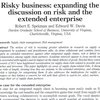 Why such a title for today’s post? The abstract of the 2004 article Risky business: Expanding the discussion on risk and the extended enterprise by Robert E Spekman and Edward W Davis promises to highlight six areas of supply chain risk and discuss these at length, showing how they are endemic to the extended enterprise, and develop a typology for categorizing them. And indeed, a lengthy discussion it is, hence the “rambling“. That said, it is a lengthy discussion not to be missed.
Why such a title for today’s post? The abstract of the 2004 article Risky business: Expanding the discussion on risk and the extended enterprise by Robert E Spekman and Edward W Davis promises to highlight six areas of supply chain risk and discuss these at length, showing how they are endemic to the extended enterprise, and develop a typology for categorizing them. And indeed, a lengthy discussion it is, hence the “rambling“. That said, it is a lengthy discussion not to be missed.
Six areas that relate to supply chain risk
I have to say this at once: The article isn’t immediately reader-friendly, not at first glance. It took me a while to find the six areas they point to in their abstract; by simply counting the headings in the article I only found four. Nonetheless, the six areas are:
- The inability to meet customer demand
and the the cost of unwanted or obsolete inventory - The flow of information
- The flow of money
- The security of the firm’s information system
- The interdependence of supply chain partners
- The need for corporate social responsibility
And the reason why I only found four was that the first three were summed up as one, perhaps reflecting the classic view of the supply chain as a flow of boxes, bytes and bucks. In my opinion, instead of highlighting six they have highlighted four areas. Still, these are four very important areas:
Risk: supply chain flows
The article lists a number of examples of typical risks in material flows
- Supplier capacity constraints
- Quality issues
- Changes in product design and production processes
- Inability to reduce costs
- Unanticipated delays and supply disruptions
and risks in information flows
- Incorrect transmission of orders
- Hesitancy to share information
- Lack of transparency
as well as risks in money flows
- Currency fluctuations
- Poor credit ratings of suppliers or customers
These risks are often interrelated and hard to separate from each other. However, so the authors say,
These risks reflect the more traditional views of the supply chain that captures primarily a logistics view of the relationship between trading partners. While it is important to acknowledge these risks […] there are other less obvious risks to manage.
And so they go on to describe these risks…
Risk: security
Security in supply chains is more than just physical security. Most of all,
with increasingly closer ties and shared information in the supply chain, also come risks associated with intellectual property, trade secrets, an the unwanted access to and/or destruction of proprietary information
such as:
- Denial of service
- Malicious hacking
- Compromised access
- Theft of proprietary information
- Financial fraud
- Theft of equipment and supplies
Unfortunately though, security is often perceived as a hindrance to efficiency, and many companies will shy away from too much security, even when they would need it.
Risk: opportunistic behavior
As firms start working closely together, the social fabric of the supply chain becomes important in addressing supply chain risks. In supply chain risk management then,
There must be a marked transformation in behavior and mindset that goes byond the logistics activities that comprise the supply chain linkages, and managers must re-focus on relationships that develop among supply chain partners. Such relationships, based on mutual trust, form the mortar and hold the network together.
Wise words. But keep in mind that
The dilemma surrounding any collaborative supply chain relationship is that with closeness comes the fear of opportunism, where one supply chain partner acts in self-interest, to the detriment of the others.
The authors point at that the relationship between buyer and supplier naturally is in a state of conflict and that trust is not something that is easily acquired. All firms are snakes, says Cousins (2002) and he may be right here. Svensson (2004), too, reflects on the gap between dependence and trust and how they interact. And let’s not forget Das and Teng (2001) who asked whether strategic alliances really can work. Trust is a two-sided sword.
Risk: corporate social (ir)responsibility
Corporate social responsibility is an often overlooked risk. In supply chains this responsibility extends beyond one’s own firm, and must also take into account the actions of suppliers’ suppliers or suppliers’ trading partners. Accepting responsibility and legal liability for actions not immediately related to oneself becomes part of the larger picture any company must acknowledge.
Essentially, outsourcing leads to companies having lesser and lesser control over their supply chains, and this lack of control can ultimately create problems, because
If we tout the advantages of blurred boundaries between firms, we must also be prepared to manage the parallel risks that reflect the consequences of our partners’ policies and actions on envrionmental and ethical issues.
The dangers of outsourcing lie in the specialization of supply chain partners and thus a fragmentation not only of the supply chain, but also of legal and ethical values and responsibilities. Common shared values, so the authors say, are the key to success in the extended enterprise.
Risk management: Trust
What managing these risks comes down down to, and that is how I understand the article, is building trust in the supply chain. It is only through trust that these risks can be managed. Trust, so they say, can be developed through these steps:
- Ensure open lines of communication
- Establish an appropriate governance structure
- Walk in your partners’ shoes
- Assess and determine your partners’ trustworthiness
The article highlights that
A good supplier does not necessarily make a good partner.
Competence, state-of-the-art technology, innovativeness, cost competitiveness and quality of management are important, but the mutuality of visions and values is more important, and most important, perhaps, is how a potential partner will handle the legal and ethical challenges described above.
Conclusion
Seemingly incoherent at first reading, the article does improve the more often I read it. Interestingly, Spekman and Davis see the above risks as a hierarchy, with the flow risks forming the basis for the management of information security risks, which extend towards trust risks and finally, risks related to corporate social responsibility. The message is clear:
Can we ensure that all risks can be mitigated? No.
Can we begin to enact processes that reduce the chances of these risks affecting the performance of supply chains? We believe so.
A lengthy article, yes. But it is well worth spending the time required to read it, and spending even more time to read it well.
Reference
Spekman, R., & Davis, E. (2004). Risky business: expanding the discussion on risk and the extended enterprise International Journal of Physical Distribution & Logistics Management, 34 (5), 414-433 DOI: 10.1108/09600030410545454
Author links
- darden.virginia.edu: Robert E Spekman
- darden.virginia.edu: Edward W Davis
Related
- husdal.com: Book Review: Enterprise-wide Risk Management
- husdal.com: All firms are snakes
- husdal.com: The gap between dependence and trust
- husdal.com: Can strategic alliances work?












